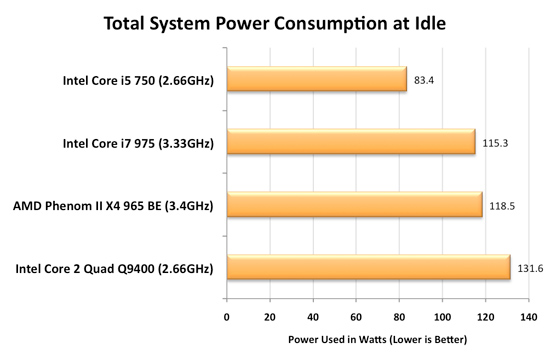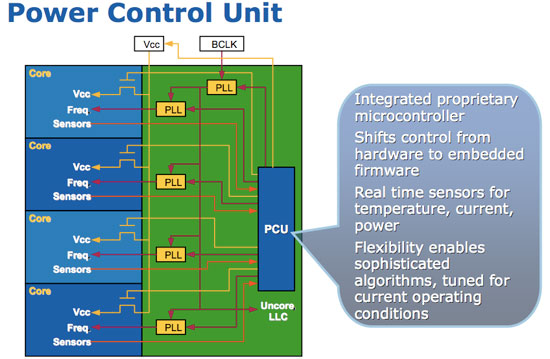Intel's Core i7 870 & i5 750, Lynnfield: Harder, Better, Faster Stronger
by Anand Lal Shimpi on September 8, 2009 12:00 AM EST- Posted in
- CPUs
Homework: How Turbo Mode Works
AMD and Intel both figured out the practical maximum power consumption of a desktop CPU. Intel actually discovered it first, through trial and error, in the Prescott days. At the high end that's around 130W, for the upper mainstream market that's 95W. That's why all high end CPUs ship with 120 - 140W TDPs.
Regardless of whether you have one, two, four, six or eight cores - the entire chip has to fit within that power envelope. A single core 95W chip gets to have a one core eating up all of that power budget. This is where we get very high clock speed single core CPUs from. A 95W dual core processor means that individually the cores have to use less than the single 95W processor, so tradeoffs are made: each core runs at a lower clock speed. A 95W quad core processor requires that each core uses less power than both a single or dual core 95W processor, resulting in more tradeoffs. Each core runs at a lower clock speed than the 95W dual core processor.
The diagram below helps illustrate this:
| Single Core | Dual Core | Quad Core | Hex Core | |
| TDP |  |  |  |  |
| Tradeoff |  |  |  |  |
The TDP is constant, you can't ramp power indefinitely - you eventually run into cooling and thermal density issues. The variables are core count and clock speed (at least today), if you increase one, you have to decrease the other.
Here's the problem: what happens if you're not using all four cores of the 95W quad core processor? You're only consuming a fraction of the 95W TDP because parts of the chip are idle, but your chip ends up being slower than a 95W dual core processor since its clocked lower. The consumer has to thus choose if they should buy a faster dual core or a slower quad core processor.
A smart processor would realize that its cores aren't frequency limited, just TDP limited. Furthermore, if half the chip is idle then the active cores could theoretically run faster.
That smart processor is Lynnfield.
Intel made a very important announcement when Nehalem launched last year. Everyone focused on cache sizes, performance or memory latency, but the most important part of Nehalem was far more subtle: the Power Gate Transistor.
Transistors are supposed to act as light switches - allowing current to flow when they're on, and stopping the flow when they're off. One side effect of constantly reducing transistor feature size and increasing performance is that current continues to flow even when the transistor is switched off. It's called leakage current, and when you've got a few hundred million transistors that are supposed to be off but are still using current, power efficiency suffers. You can reduce leakage current, but you also impact performance when doing so; the processes with the lowest leakage, can't scale as high in clock speed.
Using some clever materials engineering Intel developed a very low resistance, low leakage, transistor that can effectively drop any circuits behind it to near-zero power consumption; a true off switch. This is the Power Gate Transistor.

On a quad-core Phenom II, if two cores are idle, blocks of transistors are placed in the off-state but they still consume power thanks to leakage current. On any Nehalem processor, if two cores are idle, the Power Gate transistors that feed the cores their supply current are turned off and thus the two cores are almost completely turned off - with extremely low leakage current. This is why nothing can touch Nehalem's idle power:

Since Nehalem can effectively turn off idle cores, it can free up some of that precious TDP we were talking about above. The next step then makes perfect sense. After turning off idle cores, let's boost the speed of active cores until we hit our TDP limit.

On every single Nehalem (Lynnfield included) lies around 1 million transistors (about the complexity of a 486) whose sole task is managing power. It turns cores off, underclocks them and is generally charged with the task of making sure that power usage is kept to a minimum. Lynnfield's PCU (Power Control Unit) is largely the same as what was in Bloomfield. The architecture remains the same, although it has a higher sampling rate for monitoring the state of all of the cores and demands on them.
The PCU is responsible for turbo mode.










343 Comments
View All Comments
Ben90 - Tuesday, September 8, 2009 - link
Was reading it pretty casually thinking it was just a preview because i didnt think the NDA lifted yet.... then i saw a next page... looked at the tab and it has like 20 pages OMGOMGOMGOMG!!! ITS OUT LOL....Im gonna try really really hard to read the article before i go to the gaming performance though...prolly wont make itLashek - Wednesday, September 9, 2009 - link
you compare it to the Q6600 a lot in the text, but no comparison with an overclocked Q6600 is made in the benches...If you have figures of an overclocked Q6600, could you add them? all over the web these question are asked but business leaders who own these web sites dont want to challenge a overclocked core 2 duo,and quads,or is it politics?
coldpower27 - Thursday, September 10, 2009 - link
You will have to compare an overclocked I750 or i860 to the Q6600 as that would only be fair, no sense doing a stock vs overclocked comparison.It is well known you can equal todays stock performance by overclocking to some degree, but if your going to compare overclock then you need to overclock both processors.
Q6600 will be destroyed by i750 and i860 if you compare perf/watt however.
Joshaze - Wednesday, September 9, 2009 - link
Anand,When testing World of Warcraft what processAffinityMask value where you using?
The default value for this variable does not take advantage of all cores on the Core i7 processors.
Here is the article discussing the CVAR: http://forums.worldofwarcraft.com/thread.html?topi...">http://forums.worldofwarcraft.com/thread.html?topi...
The value should be 255 for 8 cores and 15 for 4 cores.
If not, any chance you could retest using the above values and report back on any changes?
Googer - Wednesday, September 9, 2009 - link
The lack of PS2 is a real deal killer for me, I have a beloved IBM Clicky Model M keyboard (1391401) and I will not give it up for anything. I know PS2-usb keyboard adapter exist but they just don't work very well.I am not alone, there are tens of thousands of vintage keyboard lovers out there and the IBM Model 1391401 is one of the more popular ones among keyboard aficionados.
Kind of sad that a 20-30 year old keyboard still works as well as they day it was made, new cheaper keyboards are less acuurate, uncomfortable, very flimsy and are poorly made. You would be lucky to get 5-6 years out of 'some' of these newer $90+ keyboards.
Save PS2, keep it alive. PS/2 has less lag than any USB keyboard I have tried. There are a lot of great keyboards still in use. There is no shortage of real estate on the back IO shields, so there should be no reason not to include a PS/2 port..
MamiyaOtaru - Thursday, September 10, 2009 - link
Seconding this. USB is incapable of providing n-key rollover for keyboards. PS2 can. Not everyone needs that, but I won't do without it.Zoomer - Wednesday, September 9, 2009 - link
I saw at least one PS2 port on these motherboards. What are you talking about again? Yes, they seem to be shared with the PS2 port for mice, but mice work the same on USB anyway.Taft12 - Wednesday, September 9, 2009 - link
This is probably the most off-topic post I've seen on this site. Fortunately for all of us, your rant is invalid and you never have to say anything about this ever again:http://www.syba.com/index.php?controller=Product&a...">http://www.syba.com/index.php?controller=Product&a...
boogerlad - Tuesday, September 8, 2009 - link
where't ta152h now? That idiot is finally done trolling.snakeoil - Wednesday, September 9, 2009 - link
all the results of this review are biased because they were made with turbo enabled, that's at least 600 mhz overclocking.to be fair you must compare this results against a phenom 2 overclockded at least 600 mhz
people is not stupid.